updated: 6 Feb 2001

Irako
Japanese refrigeration ship, displacement 9,570 tons, length 147 meters. Location: At the mouth of Coron Bay
Probably the best wreck dive in the Philippines. The Irako is quite intact and because of the good visibility you know you are on a big shipwreck. Big groupers, schools of tuna and yellow fin, lion fish and scorpion fish live around this wreck. Two sea turtles live in the crumpled and folded metal of the superstructure. There is a beautiful deep penetration through the engine room for trained, experienced and properly equipped divers.
Irako usually has the best visibility of all the wrecks in Coron Bay.
Co Webb supplied information about US Navy WWII activities in the Pacific. He wrote:
Hi Mark
I have attached excerpts of the official 1955 USN chronology of all USN operations in WWII covering the Philippines for Sept-Nov 1944 which gives some of the context of TF 38's operations during the period. I note that it says Irako was both damaged and sunk in the strike on 24 September. The same source also says that Irako was damaged on 20 January 1944 by US Submarine Seadragon (SS-194) in 08°04'N, 152°40'E, Northwest of Truk.
![]() This dive is best made at deck level while breathing 32% Nitrox for a 50% increase in allowable bottom time. Penetration of the interior would require 30% or 28% Nitrox depending on which deck level you wish to swim through.
This dive is best made at deck level while breathing 32% Nitrox for a 50% increase in allowable bottom time. Penetration of the interior would require 30% or 28% Nitrox depending on which deck level you wish to swim through.
Max depth: 43 meters on the bottom, deck level at 28 to 35 meters. Recommended certification level: Advanced Open Water Diver, Deep Diver Specialty, Wreck Diver Specialty.
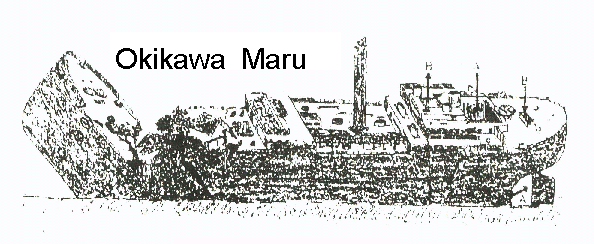
Okikawa Maru
Japanese tanker, 168 m long. Location: Busuanga Island, 2 miles south of Conception. In length, width, and volume the largest of the Coron wrecks. At this depth you may be able to make an hour-long dive.
If the Irako isn't the best wreck dive in the Philippines then the Okikawa Maru certainly is! This wreck is totally covered with beautiful corals and offers a large variety of marine-life. The deck is between 10m and 16m and is good for wreck dive beginners. There are many penetration possibilities for advanced wreck divers including penetrating up the propeller shaft from the outside of the ship all the way into the engine room. Strong tidal currents often affect this wreck. Diving in strong currents lets you see the most fish. At the bow you can see the resident three legged turtle and a school of snappers holding position into a slight current. Large fish shelter out of the current behind crumpled metal and inside of the deckhouses.There is also a large resident grouper near the bottom.
![]() This dive is best when made while breathing 36% or 38% Nitrox for a 75% increase in allowable bottom time. Dives in excess of one hour are common on the Okikawa Maru.
This dive is best when made while breathing 36% or 38% Nitrox for a 75% increase in allowable bottom time. Dives in excess of one hour are common on the Okikawa Maru.
Max depth: 26 meters on the bottom, 10 to 16 meters on the deck. Recommended certification level:
1. Diving outside the deck without a current. Open Water Diver
2. Diving with a current. Advanced Open Water Diver
3. Diving with a strong current. Experienced Advanced Open Water Diver
4. Penetration dive. Wreck Diver Specialty

Akitsushima
Japanese Seaplane Tender 118 m long. Location: Between Culion & Busuanga Islands, near Manglet Island.
The Akitsushima is a very big warship that lies on her port side. She was hit near the stern where the flying boat rested on the metal tracks and sank immediately. The ship was almost torn into two pieces. The flying boat disappeared. Only half of the metal on the starboard side and half of the metal on the bottom of the ship kept the stern from separating from the rest of the ship. The internal damage is impressive.
The crane used for lifting the seaplane out of the water is intact. The crane is lying on the sandy bottom and attracts schools of giant batfish and barracudas. One mounting of a 3-barreled AA (antiaircraft) gun is still present at the front of the flying boat tracks. This is a fascinating dive where you can see giant groupers, schools of barracuda hiding under the bow, and yellow fin tuna.
Due to depth and metal hazards within, no swim throughs are allowed without wreck diver certification. Wreck divers can make an impressive penetration into the engine room to see the four engines. The gears and machinery for operating the crane are the main objects of interest for a penetration into the stern.
The following is credited to David Hendricks from Guam who is a great dive buddy as well as a great guy.
Say, you are aware, aren't you, of the Akitsushima wreck. That it was bombed twice in Truk, but survived? A great picture and write up are in Dan Bailey's book, "WWII WRECKS OF THE KWAJALEIN AND TRUK LAGOONS". Dive bombers from the carrier USS Enterprise dropped two 1000 pound / 454 kg bombs. One hit forward of the bridge and the other at the extreme stern at 0620 on 16 Feb 1944. The next day, it was hit again. One bomb hit just aft of amidships. An explosion resulted in a large fire. Akitsushima was reported to be an aft engine ship. Painted grey, it was originally mistaken to be a tanker. It must have been repaired and made it to Coron. Neat stuff.
![]() This dive is best made while breathing 31% or 32% Nitrox for a 50% increase in allowable bottom time.
This dive is best made while breathing 31% or 32% Nitrox for a 50% increase in allowable bottom time.
Max depth: 35 or 36 meters, average depth about 26 to 28 meters. Recommended certification level: Advanced Open water Diver. For penetration: PADI Wreck Diver specialty.
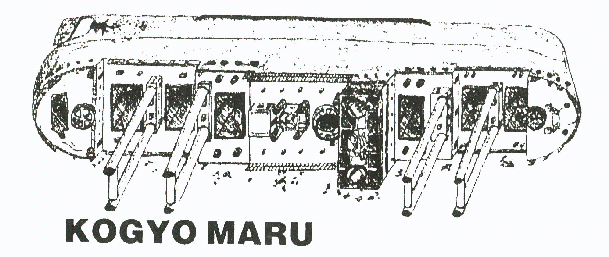
Kogyo Maru
Kogyo Maru was a Japanese freighter carrying construction materials for building a runway for the Japanese war effort in the Pacific. Kogyo Maru was built in 1938 and is 158 m long with a displacement of 6,353 tons. Lying on her starboard side in 36 meters of water the Kogyo Maru offers swim throughs into all six holds and through the engine room and bridge area. Kogyo Maru's second hold contains an incline of cement bags which tumbled as the ship sank. A small bulldozer draws your attention as you swim into the hold. Complete but encrusted, you can imagine the operator sitting in the seat and working the control levers to carve a runway out of a tropical island. Engrossed in the bulldover you might fail to look up the incline of cement sacks and so miss the tractor and air compressor perched above it. Take the time to swim up and look at both pieces and see how many of the engine parts you can identify. It's complete. Check out the metal wheels on the tractor. Coming out of the hold swim up the front mast, now horizontal, and on your left side. At the top of the mast look at the crow's nest and imagine what a lookout would experience when perched 30 meters above the water in a Japanese winter storm. Swim back over the deck to the bridge and engine room below it. Enter both from the stern side for easier access. Swim through the cavernous engine room and look at the hardware then out through the bridge. If air is low go up to the port side of the bridge and look at the soft corals growing there and the fish life living on this artificial coral reef at 22 meters. If you have enough air continue below deck level to the stern looking at all of the deck hardware for moving cargo and working the ship. Pass around the stern and then go forward over the port side to return to the mooring line. You pass over hard and soft corals covering the side of the ship. On this dive keep your head and eyes moving like a fighter pilot's to see the school of barracuda which will swim by. If you only look at the Kogyo Maru you will miss the barracuda.
![]() This dive is best when made while breathing 31% or 32% Nitrox for a 50% increase in allowable bottom time. If you dive the Kogyo Maru with a 100 cubic foot tank of Nitrox 32 you have enough gas mixture and a long enough No Decompression Limit to cover the whole ship on one dive.
This dive is best when made while breathing 31% or 32% Nitrox for a 50% increase in allowable bottom time. If you dive the Kogyo Maru with a 100 cubic foot tank of Nitrox 32 you have enough gas mixture and a long enough No Decompression Limit to cover the whole ship on one dive.
Max depth: 34 m, average 24-26m Recommended certification level: Advanced Open Water Diver, Wreck Diver Specialty.
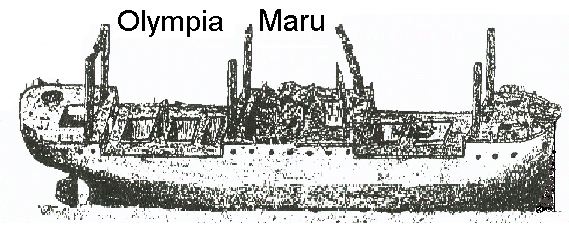
Olympia Maru
Japanese Freighter sitting upright with a length of 122 meters. Location: Coron Bay.
A very good dive spot with a variety of marine life. Large shoals of banana fish, giant bat fish and giant puffer fish, especially around the mast, bow and stern. Easy penetration at the cargo rooms. It offers a good opportunity to discover wreck diving.
![]() This dive is best when made while breathing 36% Nitrox for a 75% increase in allowable bottom time.
This dive is best when made while breathing 36% Nitrox for a 75% increase in allowable bottom time.
Max depth: 28-30 meters, deck level 18-24 meters. Recommended certification level: Advanced Open Water Diver, Wreck Diver Specialty.
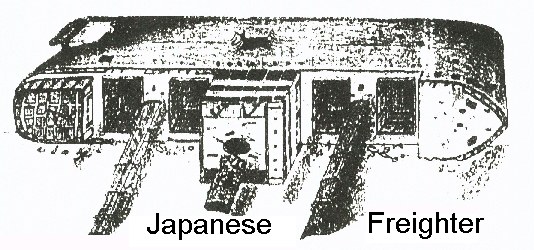
Japanese Freighter (Taiei Maru?)
Japanese freighter 137 meters long, lying on its starboard side. Location: Coron Bay
This is a beautiful wreck dive site where you can observe groupers, sweetlips, occasionally turtles and sea snakes. Hard corals cover the port side, which is only 12 to 16 meters below the surface. See if you can find the two resident trumpet fish that hang out half a meter over the part side corals. Many scorpion fish hang out around the wreck area. Keep your eyes open and stay neutrally buoyant!
The big cargo rooms and the engine room allow easy penetration of this wreck for Wreck Diver Certified divers. If you dive from 10 AM to 2 PM on a sunny day you get a cathederal like effect from the beams of sunlight entering the cargo holds through the holes in the port side. The two massive boilers in the center of the ship are a big attraction on this dive. You can pass behind the boilers and see the damage resulting from one of the bomb strikes that disabled the ship. It is possible to do a swim-through and pass from bow to stern without exiting the ship.
![]() This dive is best when made while breathing 36% or 38% Nitrox for a 75% increase in allowable bottom time.
This dive is best when made while breathing 36% or 38% Nitrox for a 75% increase in allowable bottom time.
Max. depth: 25 meters, average about 15 meters. Recommended certification level: Open Water Diver, Advanced Open Water Diver, Wreck Diver Specialty
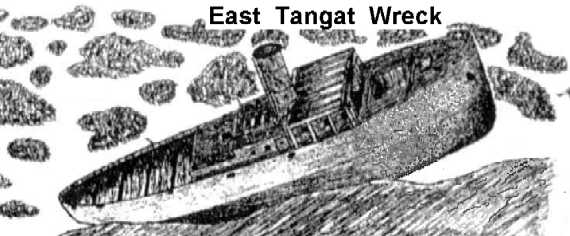
East Tangat Gunboat
This ship was a small gunboat or submarine hunter 40 meters long. Location: Inclined on the coral reef on the east side of Tangat Island.
This dive site is good for wreck diving beginners and underwater photographers. It is also a lovely dive between deeper wreck sites. The wreck starts at only 3 meters down so even snorkelers can see the shape and explore the bow of the ship.
![]() This dive is best when made while breathing 36% or 38% Nitrox for a 75% increase in allowable bottom time.
This dive is best when made while breathing 36% or 38% Nitrox for a 75% increase in allowable bottom time.
Max depth: 22 meters. Recommended certification level: Skin Diver, Open Water Diver.
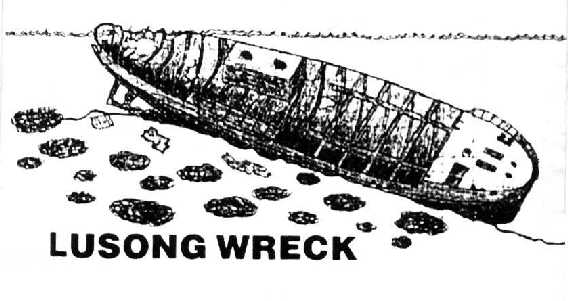
Lusong Island Wreck
This wreck was also a gunboat or submarine hunter. The stern breaks the surface at low tide. Location: In front of the east side of Lusong Island.
This wreck is great for snorkeling. It is nicely covered with hard corals and offers a nice variety of fish life. The are good opportunities for wreck dive photographers. The dive is good as a "dive between dives."
Max depth: 11 meters. Recommended certification level: Skin Diver, Open Water Diver.
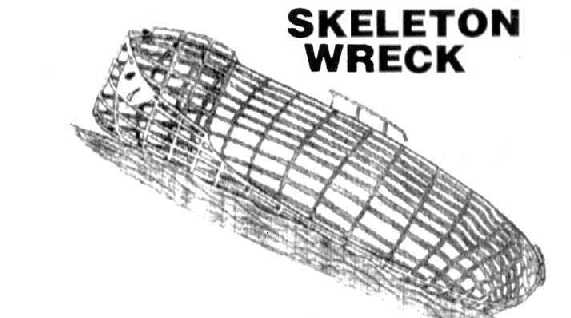
Skeleton Wreck
This wreck is the keel, ribs and stringers of a steel-hulled boat about 25 meters long. Location: Northwest corner of Coron Island
This wreck was beached with the bow a dozen meters from Coron Island. The stern points directly away from the island. The wreck slopes along the reef from 5 meters deep at the bow to 22 meters at the stern. A pass through on the starboard side of the hull at 14 meters allows you to swim from the inside of the boat out over the coral reef.
![]() This dive is best when made while breathing 36% Nitrox for a 75% increase in allowable bottom time.
This dive is best when made while breathing 36% Nitrox for a 75% increase in allowable bottom time.
Max depth: 22 meters on the bottom. Slopes from 7 to 22 meters. Recommended certification level: Skin Diver, Open Water Diver.
The Fishing Boat
Location: Coron Island. A recently sunken fishing boat approximately 35 meters long at Coron Island, near the entrance to Cayangan Lake. This is an easy wreck dive site for all beginners or in combination with the Coron drop off. It is also a very interesting night dive site.
Max depth: 16 meters. Recommended certification level: Open Water Diver.
Barracuda Lake
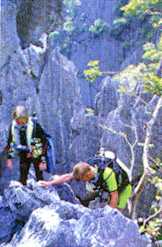 "The craziest dive site in the Philippines."
"The craziest dive site in the Philippines."
Location: North end of Coron Island.
This spectacular dive starts with some challenging mountain climbing in full diving equipment over sharp limestone cliffs. We do wear tennis shoes or sandals and carry our fins strapped to our tank. We use 53 cubic foot tanks for this dive as they are more than 4 kilograms lighter than the usual aluminum 80. The climb only takes 10-15 minutes and the exertion is worth it. The scenery around the lake is spectacular and the under water terrain has been likened to flying over the surface of the moon. The top 4 meters is warm fresh water. Below 4 meters the water is salt. There are dynamic changes of water temperature in the lake with temperatures ranging from 28 to 38 Celsius. You can even see the thermoclines at 4 and 14 meters. At 34 to 35 meters the water changes from crystal clear to tea brown due to the tannic acid in the leaves that fell into the lake. After cooking and boiling, you will meet the "king of the lake." It is a barracuda approximately 1.5m long that likes to guide divers around his domain. It is a good chance for underwater photographers to get a close-up of the big barracuda. A dive that you should not miss!
Max depth: 35 meters. Recommended certification level: Open Water Diver, Mountain Climbing Diver Specialty.
Cathederal Cave
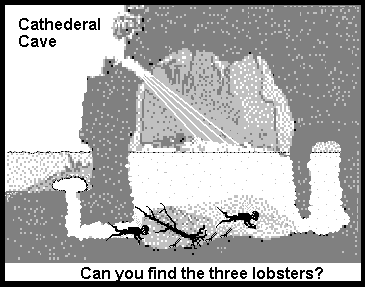
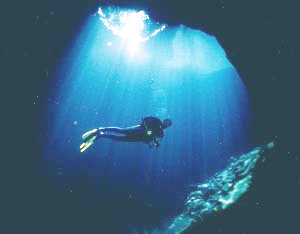
A cave under Coron Island, Palawan directly connected to the sea. Location: South end of Coron Island on the East side.
Cathedral Cave is a beautiful dive spot. It starts 6 meters deep at a hole in the bottom of the sea next to the sheer rock wall of Coron Island. You enter a tunnel and descend to 12 meters. If you take the time to look, you see the antenna of juvenile lobsters waving from holes in the tunnel above and out from under the rocks below and cowry shells clinging to the ceiling of the tunnel. Then you pass out of the tunnel and see a shaft of daylight penetrates the interior of a cave. The roof of the cave has collapsed sending down a full sized tree. The skeletal trunk and main branches of the tree rest on top of the sand mound in the middle of the cave. You follow the light and surface inside a big underground cathedral. You pass over the sand dune and continue ahead and left to another passage that leads to a chamber with an air pocket above ocean level. Back through the tunnel into the open sea and you dive among beautiful corals with 20 to 30 meter visibility. A dive you should not miss!
Maximum depth: 10 meters inside the cave. Recommended certification level: Advanced Open Water Diver, Cavern Diver Specialty.
Weather Advisory: Cathederal Cave MUST ONLY BE ATTEMPTED in calm weather with slight waves. It would be physically dangerous to attempt to enter the tunnel in the surge generated from large waves.
The Cave in Barracuda Lake
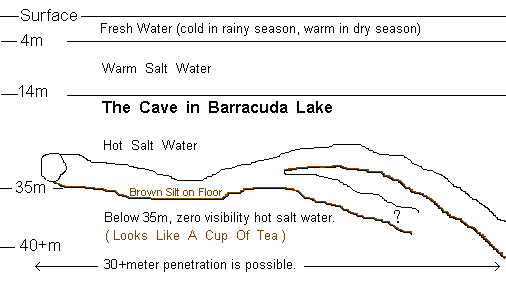
A very deep and serious cave in Barracuda lake entered from Barracuda Lake at 33 meters depth which allows a penetration of 30 meters. Location: North Wall of Barracuda Lake starting at 33 meters deep.
The cave has been marked with a fixed line on the right side as you enter. The cave is just large enough to allow one diver to swim in and turn around. The silt and sediment on the bottom is packed and should remain down with reasonable care by the diver. This cave is dark and the sediment is dark and gives an eerie sensation. Proper equipment would be a light with backup and at least an octopus with a 7-foot hose or redundant alternate air source. The current in the cave tells you that it is connecting Barracuda Lake to the ocean. This is a dive that you should not miss if you are prepared. The combination of mild nitrogen narcosis at depth and the dark confined surroundings on this dive will tell you if you are claustrophobic for continued cave diving.
Max depth: Please do not descend below 40 meters!
Recommended certification level: If you limit your penetration to a maximum of 40 meters total distance from the surface (a 6 meter penetration) then Advanced Open Water Diver with Deep Diver Specialty and Cavern Diver Specialty is sufficient. If you wish to penetrate beyond 40 total meters from the surface then you should be Cave Diver trained and carry the necessary redundant equipment.
Nanshin-Maru tanker
(Civilian tanker / 834 gt.) The so-called "Black Island Wreck" can be easily identified as a small tanker converted to carry specific fuel (gasoline, Diesel, lube oil etc.) in small isolated tanks for replenishment of land-based depots. The ship is approximately 50 meters long sitting upright on a sandy bottom.
Location: Close to Black Island Beach in front of the stranded vessel. This wreck is located 3.5 hours away from Dive Right. It is done as a day trip with a 7 AM departure. We would normally make one dive here and dive the Okikawa Maru as a second dive on the return trip. This dive site is perfect for beginner wreck divers and underwater photographers. It is a beautiful dive in clear water. You can see plenty of scorpion fish, lion fish, trumpet fish, groupers, and bat fish.
![]() This dive is best when made while breathing 32% Nitrox for a 50% increase in allowable bottom time.
This dive is best when made while breathing 32% Nitrox for a 50% increase in allowable bottom time.
Max depth: 32 meters. The wreck starts in 21-meter deep water. Recommended certification level: Advanced Open Water Diver, Wreck Diver Specialty.
HISTORY OF THE ERROR IN NAMING THIS WRECK: The Japanese had many ships named Nanshin Maru. One Nanshin Maru was a Japanese freighter sunk in the Malacca Straits by a US submarine. There was also a tanker, the Nansai Maru ex. British oiler Ploiden, sunk at Black Island during WWII. This ship was captured in Hong Kong and renamed by the Japanese. The location of the Nansai Maru is not definitely known. It may be on the opposite side of Black Island in 60 meters of water.
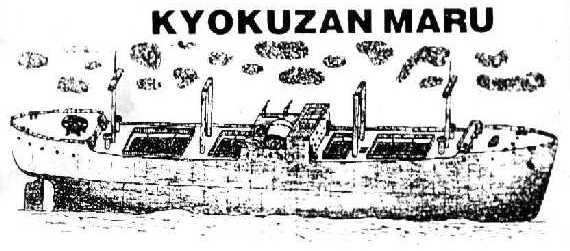
Kyokuzan Maru
Japanese freighter approximately 160-180 meters long.
Location: Northeast of Busuanga Island. Due to it's distance from Coron this wreck is dived by a one hour jeepney ride to the north end of Busuanga and transferring to a rented dive boat. This is done as an all-day trip for two dives on the Kyokuzan Maru.
This is a beautiful wreck dive experience. More or less intact, this huge sunken ship usually offers good visibility of about 20 meters and ideal diving conditions. Japanese staff cars and trucks can be found in the cargo rooms.
![]() This dive is best when made while breathing 36% Nitrox for a 75% increase in allowable bottom time.
This dive is best when made while breathing 36% Nitrox for a 75% increase in allowable bottom time.
Max depth: 40 meters on the bottom. The deck level lies between 22 and 28 meters. Recommended certification level: Advanced Open Water Diver, Wreck Diver Specialty.
Dos Islas (Two Islands) Reef
A 300 meter by 50-meter coral reef and drop off. Location: North shore of Coron Island West of two small islands.
This reef is just at the surface at low tide and each side drops off into deeper water. The outstanding features of this reef are large formations of pristine staghorn coral and table corals. Underwater you will find a saddle connects the two small islands. There are schools of reef fish and juvenile barracuda. There are 13 resident Napoleon Wrasse and two Hawksbill Sea turtles.
Max depth: 22 meters. Recommended certification level: Open Water Diver